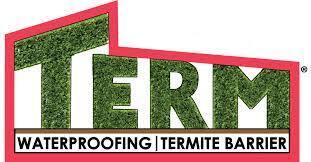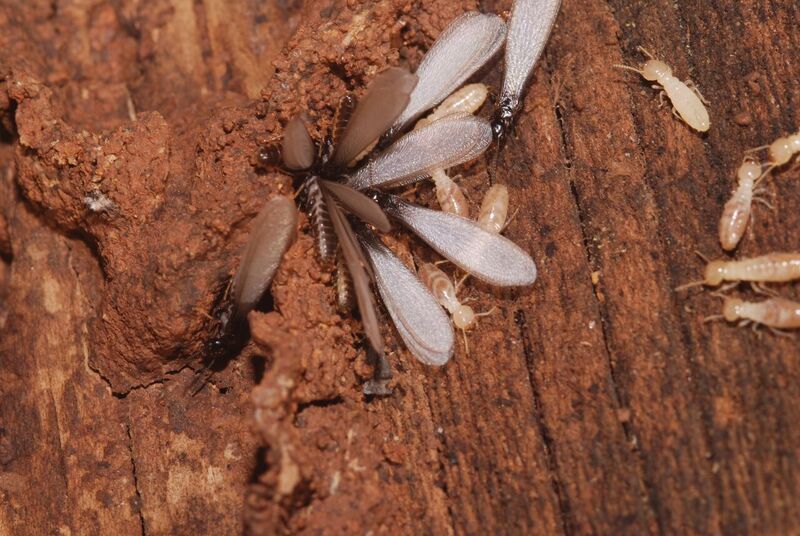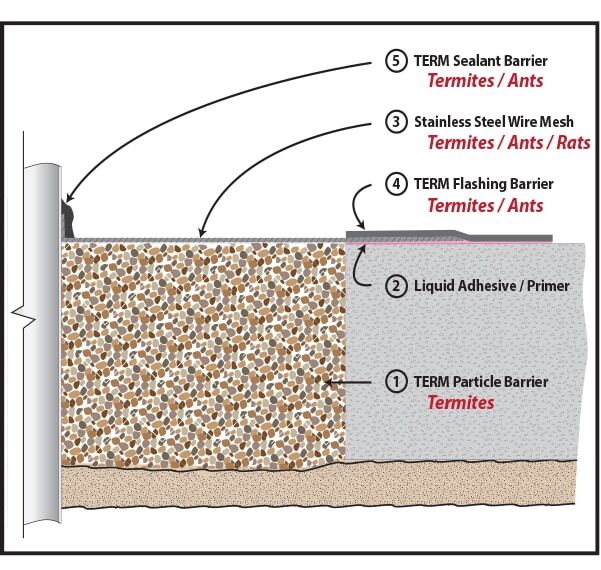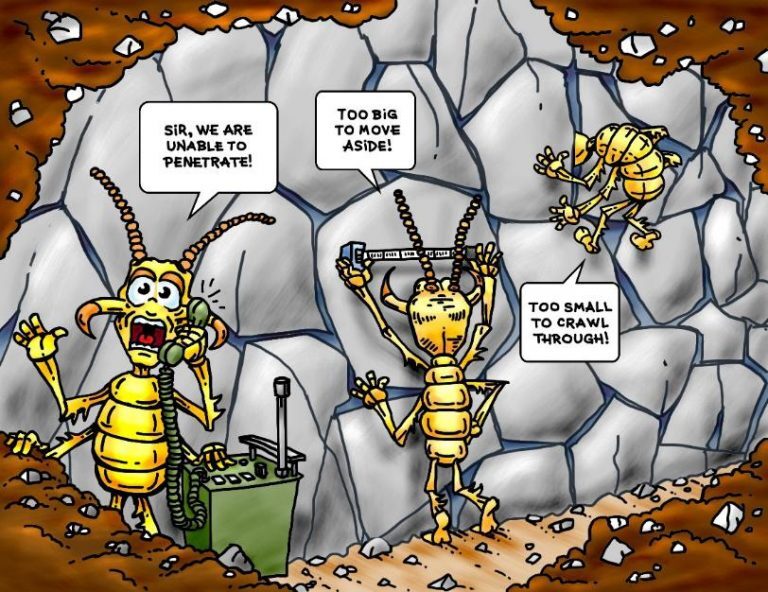TERM waterproofing with non-chemical termite barriers offers a superior solution to blocking termites in subfloors. Since 1999, Polyguard and entomology scientists have worked together to develop a non-pesticide, waterproofing/termite physical barrier.
Our product stops termites from entering a home or building through slab penetrations, bath traps, cracks or joints in the floor, spaces where concrete slab intersects with exterior sheathing, across the horizontal floor surface, cold joints, and foundation.

Termites pose a significant threat to the integrity and value of your home or building. Therefore, protecting your investment requires the implementation of termite prevention methods (like the Polyguard non-pesticide physical termite barrier) and immediate remediation if you discover termites.
Termite Damage

Each year, termites cause up to $5 billion in damages in the U.S., affecting our houses, commercial buildings, decks, boats, trees, and more, making termite prevention and control necessary. Termites will weaken and warp the structural frame or building. Signs that you have a termite problem include,
Sticking or not opening and closing properly windows and doors
House settling, causing the floor to sink
Water-like damage on your ceiling
Bubbling behind paint and wallpaper
Honeycomb-like denting (caused by tunneling termites) on the surface of your hardwood baseboards, window, and door frames
Termites can also damage the inside of your building or home, eating anything that contains cellulose: books, clothing, cardboard, etc. In addition, termites will attack wood fences, outbuildings, firewood piles, and other wood that is exposed to the outdoors.
Types of Termites
Nearly 2,800 species of termites live on the planet, but only a few cause us problems: Subterranean, Formosan subterranean, Drywood, and Dampwood termites.
Subterranean Termites
Subterranean termite groups or colonies live underground in loose, damp soil
and survive on wood. They represent 95 percent of the termite damage in North America. A colony of subterranean termites can include one million members, eating up to 15 pounds of wood per week, destroying home foundations, support beams, insulation, plastic pipes, and more.
Subterranean termites form structures by building mud tubes that provide a moist, protective passageway from one location to another from the ground to deck posts, door frames, porch steps, cracks in the foundation, or brick mortar.
Subterranean Termite Damage
Termites often damage a house or building long before the owners realize they have a full-blown infestation. Termites and moisture damage look similar - buckling wood, and swollen ceilings and floors. Home and building owners should immediately begin remediation when they see signs of subterranean termites.
The presence of mazes within the furniture or walls
The smell like mildew or mold
Mud tubes or tunnels made from termite saliva, soil, and wood, typically located near the foundation of a structure
Formosan Termites
The highly destructive Formosan subterranean termites arrived from China possibly in infested wooden railroad stakes. A single Formosan subterranean termite colony may contain several million termites. These termites infest wood and other cellulose-based goods, like boats. While most commonly found in Louisiana, the risk also exists in New Mexico, California, North Carolina, South Carolina, and Georgia.
Formosan termites enter structures where the wood touches the soil, and they travel through mud tubes from the ground to wood, often entering through openings created by unsealed joints or cracks. Swarmers may also infest roofs and other above-ground spots.
Signs of Formosan Termites Include:
Swarmers near lights, doors, and vents
Wood that sounds hollow when tapped
A grain pattern in the wood, caused by feeding termites
Drywood Termites
Drywood termite colonies typically live above ground, inside walls, door and window frames, and furniture and trees, feeding on wood from the inside out. Drywood termites get into houses and buildings by flying through unscreened vents in the attic or foundation, cracks in the window and door frames, soffits, and roof sheathing.
Drywood Termite Damage
Drywood termite-infested wood may look fine from the outside but be crumbling from within. Signs of drywood termites include:
Swarmers or flying adults, often occurring during the fall and summer
Termite fecal pellets
Cracks in veneer
Visible, maze-like tunnels
Dampwood Termites
Dampwood termites build their colonies in damp, decaying wood, mainly impacting the Pacific coast, the deserts of the Southwest, and southern Florida. They mostly threaten homes with moisture and plumbing issues. Dampwood termites get into homes or buildings through swarmers or infested lumber.
Signs of Dampwood Termite Infestation Include:
Termite fecal pellets
Dead swarmers
Soft spots in the wood
TERM Termite Barriers for Residential and Commercial Construction
Polyguard Products specialize in protecting commercial and residential surfaces and structures from moisture, water, chemicals, corrosion, radon, and other unwanted substances, including termites.
The TERM Barrier Systems Division of Polyguard Products specializes in sustainable pest barriers without pesticides. TERM means Termites, Energy, Radon, and Moisture prevention in one building envelope solution. The TERM termite barrier applications include nine components:
1. Term Termite Sealant at Slab Penetrations

TERM® Water|Termite|Sealant Barrier applies with a caulking gun or smoothing tool, and protects against water and termites. Chemical and metal-free, Term Termite Sealant can stop termite entry by:
Sealing slab penetrations, seams, and gaps
As a part of the TERM Full Bath Trap Barrier to stop termites, rodents, fire ants moles, etc. from getting underneath bathtubs at ground level
Detailing small gaps and tears found during inspection or construction on horizontal or vertical portions of the TERM building envelope pest barrier system
2. TERM Full Bath Trap Barrier
Polyguard’s TERM™ Full Bath Trap Barrier is a combination barrier that blocks termites, fire ants, mice, rats, and moles from entering through bath traps (blockouts) in a concrete slab, a common open door for pests. Contractors install the non-chemical barrier after pouring the concrete slab and completing the rough plumbing.
TERM Particle Barrier for Bath Traps

After completing the rough plumbing, TERM Particle Barrier installs in the bath trap cavity. The barriers include particles too large for the termites to move, yet too small to crawl through the aggregates. TERM Particle Barrier provides a sustainable alternative to the past method of placing heavy termiticide application used around slab penetrations before pouring the concrete slab.
3. TERM Sill Plate Barrier
The TERM® Sill Plate Barrier is an adhesive sealant that prevents termites from accessing wood framing through concrete cracks or joints in the floor, which can be significant access points for subterranean termites. Used in conjunction with TERM Flashing Barrier, it bonds to the subfloor, and blocks termite access to the sill plate.
TERM Sill Plate Barrier installed underneath the sill plate provides several benefits:
Is a non-chemical barrier to subterranean termites
Provides wood, water, and vapor proofing against moisture from the concrete
Contributes towards a tight building envelope
Stops foraging insects, such as ants and cockroaches from entering at gaps between the sill plate and unlevel slabs
Provides supplemental protection to wood framing sodium borate treatment.
4. TERM Flashing Moisture|Termite Barrier
The TERM® Flashing Moisture|Termite Barrier is a peel-and-stick barrier that provides waterproofing, energy sealing, and insect resistance. Contractors apply TERM Flashing Moisture|Termite Barrier where the horizontal concrete slab intersects with exterior sheathing, a frequent entry point for termites found on the slab’s outside or foundation wall. TERM® Flashing Moisture|Termite Barrier also prevents moisture and energy leaks at the slab and sheathing intersection.
5. TERM Wood or Tile Floor Underlayment Barrier
TERM® Wood Floor Underlayment Termite Barrier includes a 40 mils thick composite membrane of polyethylene backing and TERM Sealant Barrier, with a ½-inch extended edge that provides a complete overlap seal at the edge.
Polyguard winds the elastomeric, self‐adhesive barrier on cores with a disposable silicone‐coated release sheet that installers remove immediately before application.
When installed properly, TERM® forms a complete seal across the entire horizontal floor surface, blocking almost every entry point that a subterranean termite can find.
In addition, the barrier also provides several other significant benefits:
Protects wood underlayment and laminate flooring
Acts as a moisture barrier to protect wood flooring from moisture damage caused by moisture vapor underneath the slab
Self‐healing properties of the sealant component enable it to create a seal around any nails driven through the barrier during installation
Creates a non-structural barrier to block termites and water
Provides sound-absorbing and insulating qualities to create a quiet and warm floor
6. TERM Particle Barrier for Termites
TERM® Particle Barrier for Termites includes precisely-sized particles that form a non‐chemical barrier to Formosan and Eastern subterranean termites, significantly reducing the termiticides needed to protect homes and buildings. The particles stop termites from climbing up the side of the exposed concrete.
7. TERM Isolation Joint Barrier
The TERM© Isolation Joint Barrier, used in conjunction with TERM Particle Barrier, seals isolation joints (cold joints) that occur in the gaps where patios, driveways, and sidewalks connect with the structure, spaces where termites can infiltrate.
8. TERM Foundation Barrier
For twenty years, builders have applied TERM® Foundation Barriers to concrete or insulated concrete foundation walls to stop water and termite intrusion.
9. TERM Underslab Barrier
The TERM® Underslab Barrier provides the base component of the TERM Barrier System. It is a system that significantly lessens the need for pesticides during the structure’s lifetime.
Why Apply Polyguard TERM Non-Pesticide
Physical Termite Barriers?
Polyguard TERM Non-Pesticide Physical Termite Barriers provide a superior solution to blocking termites, energy, radon, and moisture infiltration in one building envelope solution. Preventing termites from accessing your home or building will protect the value of your structure and save thousands of dollars and hours of repair.
Don’t hesitate to contact the Polyguard® professionals today for more on keeping termites out of subfloors.
